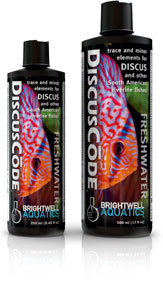Overview
- Unique complex that provides trace and minor elements in ratios found to be beneficialto discus and other fishes that share the same waters of origin.
- Provides minor and trace elements utilized in important neurological and metabolic reactions, and which are incorporated into natural biopigments for coloration.
- Replaces minor and trace elements used by aquarium inhabitants, and which are lost through chemical filtration (use of filtration media such as resins and activated carbon).
- Composed of purified water and ultra-high purity materials.
- Formulated utilizing extensive research on chemistry of the waters naturally-inhabited by discus, as well as discus trace and minor element requirements.
Sizes
125ml | 250ml | 500ml | 2L | 20L
Technical Background
The role that trace and minor elements play with discus and other fishes is related to neurological and metabolic processes (in which these elements play critical roles), as well as overall coloration (trace and minor elements are often at the core of pigments known to enhance coloration). Dosing a trace and minor supplement with every water change performed is an effective method of delivering these substances for maximum benefit.
Discus are native to many of the quiet waters of the Amazon River basin, primarily inhabiting pools, small creeks, and streams of (primarily) blackwater habitats. Low pH (5.0+/-0.5), caused by lack of buffering molecules, and low conductivity are characteristic of these waters, and while it is often the goal of the newcomer to discus husbandry to maintain their fish in these natural conditions, attempting to do so can make their care somewhat more difficult than when allowing pH and conductivity values to be slightly higher. While the majority of discus available to hobbyists were wild caught as recently as 10 years ago, captive-raised (“tank-bred”) discus are the mainstay of the dedicated hobbyist today. As such, water conditions in which discus may be maintained are quite dissimilar to those of their native habitat, largely because of the ease of raising fish in the relatively hard, alkaline water that is characteristic of the United States and much of Continental Europe (where much of the discus breeding is done; water conditions in Southeast Asia, from where the majority of captive-raised discus originate, is also harder and more alkaline than is found in a blackwater habitat). Maintaining discus within the following ranges is recommended: pH 5.5 - 7.0; dGH 10 - 15; dKH 3 - 5; obtaining the water parameters in which your discus were bred (if not wild-caught) and maintaining them in these conditions is also a good practice to follow.
A number of popular ornamental fish species, such as Cardinal Tetras and other characins, Angelfishes, Festivums, and Uaru are often found in the same waters in which discus originate; hence, DiscusCōde may also be used in aquaria housing these fishes with equal success.
Instructions and Guidelines
Basic: Shake product well before using. Add per the directions on the bottle. 500 ml treats up to 2,000 US-gallons (7,600 L). This dosage may also be used for freshwater community aquaria.
Advanced: With the exception of iron, there are no hobbyist-grade test kits that provide reliable measurements of the concentrations of many minor and trace elements present in freshwater aquaria. It's therefore not possible to chemically determine exactly how much of a trace and minor element supplement to dose; rather, you must rely on the appearance of the livestock to make that determination. Follow the directions on the bottle. Gradually increase the weekly dosage per the directions over the following four weeks and maintain this dosage. Starting at a low dosage will not cause any harm to aquarium inhabitants, and will enable you to notice subtle changes in the appearance of the system that indicate the effectiveness and need for the product. Daily dosing maintains more stable concentrations (and a more natural environment) than dosing weekly, in which the concentration of elements spikes just after dosing and then gradually decreases throughout the course of the week. Though trace and minor elements are essential to critical biological processes, the gross overdosing of a trace and minor element supplement can be harmful to aquarium inhabitants. Minor and trace elements are made unavailable in aquaria largely by adsorption to particulate organic matter (POM); therefore, aquaria with large amounts of latent organic material may require slightly heavier dosing of this product to compensate for that which is bound. In all cases, latent organic material should be removed as thoroughly as possible from aquaria because of the negative impact that it can have on water quality. The use of activated carbon will remove trace and minor elements both passively and actively, requiring that this product be dosed after the use of carbon filtration media.
Caution: Keep out of reach of children. Not for human consumption.
Ingredients
Purified water, species specific minor and trace mineral blend

